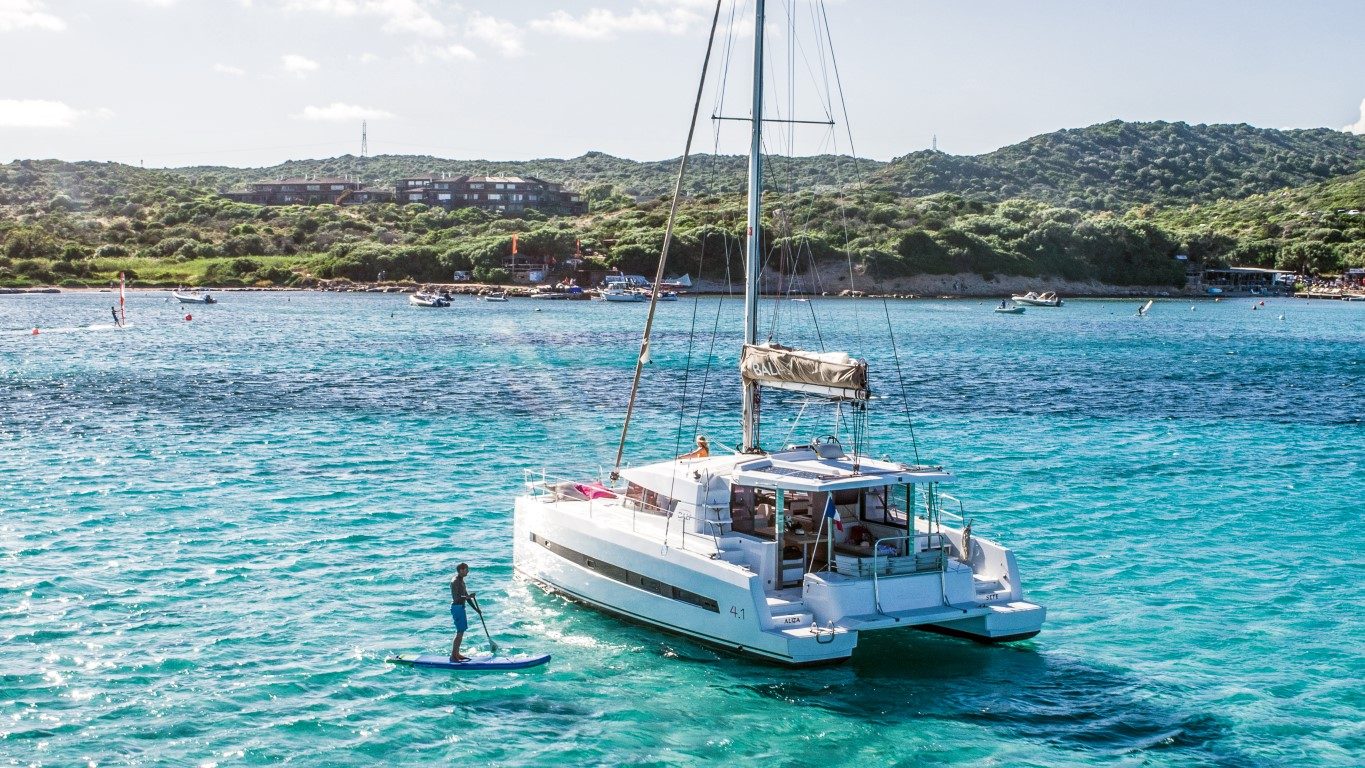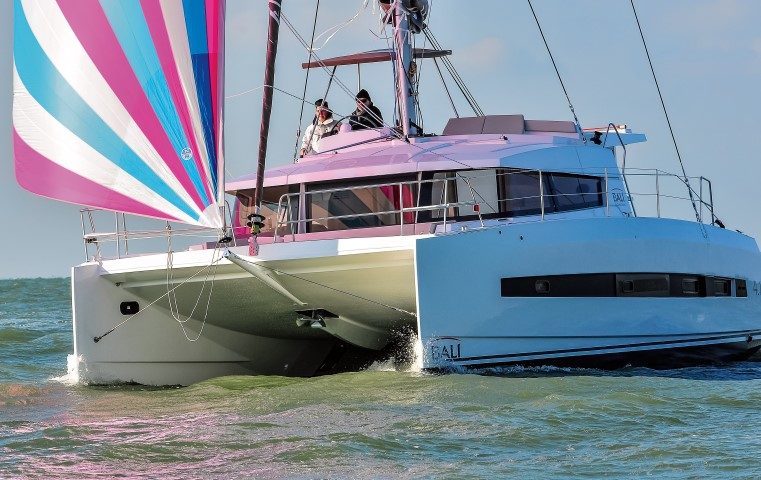‘Behemoth’ is a word which springs to mind or, perhaps more nautically, ‘leviathan’.
- Innovative rear bulkhead
- Stylish interior and decor
- Easy sail controls
- Good motoring performance

When you’re cruising, time becomes irrelevant and space is everything. The Bali 4.1 catamaran provides the ideal platform for taking it easy, with plenty of room for the family to spread out, chill and enjoy the journey.
The Bali catamaran range caused a bit of a stir when it was launched onto the market five years ago, with French manufacturer Catana turning its attention from performance cats to taking on the cruising market – in the process introducing some innovative and controversial design ideas. And now the first Bali cat has arrived here – the 12.1m Bali 4.1 – the baby of the range and a development of the original Bali 4.0 model.
The New Zealand agent for the Bali range is Dream Yacht Charter in Queensland, Australia, run by Frenchman Christophe Vanek, a former international yachtie who first came to Australia in 1986 with one of the French challengers for the Louis Vuitton Cup.
I meet Christophe and his wife Amara at Auckland’s Viaduct Harbour, where boats are being released following the On Water Boat Show. Dream Yacht Charter operates a fleet of these cats in the Whitsundays, but the boat we’re on today is privately-owned and lives at Pine Harbour Marina, east of Auckland, where we are to deliver her today.

Waiting for clearance to leave the marina gives us plenty of time to look around the boat and check out its features – the most eye-catching of which is the fact that the saloon’s entire aft bulkhead hinges up like a garage door, creating the ultimate in indoor-outdoor flow.
There’s a traditional sliding door between cockpit and cabin when the rear ‘wall’ is down, but when you’re at anchor and the weather’s right, up it goes and suddenly the interior feels twice as big. This innovative feature was initially greeted with some scepticism in the industry but has since proven to be both popular and safe. With the back door up and the saloon’s front and side windows open you are virtually living outside, yet well-protected from the sun.
“A lot of people today are sensitive about exposure to the sun, so here they can stay inside the boat, protected but in something that is completely open,” Vanek says. “Then, if the weather is bad they can just shut the whole thing down, but still have great views.”
The ‘garage door’ is easy to open, sliding up and down without much effort, secured by hydraulic struts, and has a watertight seal along the bottom edge when closed for safe passage-making.
The second aspect which makes the Bali range different to traditional sailing cats is forward of the cabin. Instead of the traditional trampoline and cross-bracing between the hulls, it has a solid wingdeck, more like a powercat. This creates a second cockpit entertaining area, handy to the galley.
“Having a trampoline isn’t really necessary anymore because the hulls are so high above the waterline,” says Vanek. The solid deck has also been designed to be lightweight, using box-section construction to avoid the boat becoming bow-heavy and unbalanced.

The cat has high topsides, allowing for generous wingdeck clearance and creating plenty of space in the hulls’ accommodation areas, but a curved sheerline visually minimises their height. The hulls feature a pronounced chine running almost the full length, with a performance-oriented shape below the waterline retaining the Catana pedigree.
The owner of this particular boat is relatively new to sailing, and is more accustomed to a powerboat experience. The Bali, with its easy handling systems and generous interior space, won’t be too much of a challenge, while adding the extra dimension of peacefulness that only cruising under sail can bring.
“Ninety per cent of the time when cruising you are at anchor, so that was the lifestyle he wanted,” Vanek says. “He was looking for a boat that had good performance but also with large entertainment areas.”
The Bali 4.1 provides three of these: the cockpit/saloon combo, the forward cockpit and a lounging area on the cabintop, adjacent to the upper helm station, up a few stairs from the side deck on the starboard side. “It’s great when you have a group of six or eight, because everyone can have a corner,” Vanek says.
Coffee and chatting over, we finally we get the nod to leave the Viaduct. The Bali proves highly manoeuvrable with her twin 40hp Yanmar diesels (with saildrives). They’re spaced well apart at the rear of the twin hulls – she virtually spins within her own length. There’s also great all-round visibility from the cabintop helm station.
Out on the harbour, pulling the mainsail up is an easy task thanks to a foot-operated Lewmar electric winch adjacent to the upper helm station. The small square-top main hoists tidily from a stack-pack on the high boom, which allows plenty of head clearance. The mainsheet runs aft to a traveller at the back of the cabintop, then forward again to the powered winch for trimming.
A self-tacking jib can also be unfurled and trimmed from here, using a non-powered winch to starboard of the helm. If you want more sail, there is an optional gennaker and code 0, to be flown off a fixed bowsprit. All the halyards and control lines are within easy reach of the helm, great for single-handed sailing.

There’s a large Raymarine chartplotter screen at the helm station, as well as the throttle controls, wind and engine instruments and a handheld VHF. A bimini can be added to this area for extra sun protection.
The boat’s designed to sail at about 12 knots downwind and 7.5–8 knots upwind, though we aren’t blessed with much wind for our trial. On a fine summer’s day this upstairs helm area would be a great place to sit and enjoy the view, but it’s still a bit chilly so we leave Vanek in charge and head down below to check out the interior comforts.
Interior
It’s very light and bright with pale upholstery, white benchtops and timber-look flooring, tabletops and door fronts, offset with bright stainless fiddles. The view is pretty much 360 degrees, through large windows on each side. There’s a large L-shaped seating area around the table to port, with a settee to starboard. The domestic-sized fridge-freezer is powered through an inverter, the batteries topped up by solar panels.

Running across the forward bulkhead on the port side, the galley opens straight onto the foredeck entertaining area via a large sliding section of the windscreen, so food and other items can easily be passed through. There’s also a double sink, under-bench oven and a three-burner gas hob.
The downstairs helm station is to port, with a cute ‘bar stool’ style helm-seat – another of the little touches which gives this boat a distinctly European feel. At first glance this helm station also appears to be missing something – a helm. Down here it’s autopilot only. There’s a VHF, a second, smaller Raymarine chartplotter screen and a single instrument display.

Down in the starboard hull are two double cabins, fore and aft, with a head and shower between. There’s plenty of headroom, and lots of light from through-hull windows. The big – and pleasant – surprise comes on the port side where the entire hull is a kind of master stateroom: a large double bed aft, a seat and bench-style dressing table with a fold-up mirror and a full head and shower room forward.
The lack of a bulkhead closing off the sleeping area makes this cabin feel incredibly spacious. Private spaces on both sides can be closed off from the galley and saloon by sliding doors at the bottom of the stairs leading down to them.

Heading out the back of the saloon is the rear cockpit, which on its own isn’t huge (this space is a different story when the ‘garage door’ is open, however). There’s a bench seat across the transom with storage underneath, and walk-throughs to boarding platforms on both sides. A dinghy can be raised on a davit across the transom when not in use, then lowered into the water using lines running to the electric winch.
 Beyond Motuihe, the wind is not in our favour, so we furl and stack the sails (again, a simple operation) and all head below. Motoring, we engage the autopilot and Vanek says this is the way most owners will use the boat – sailing when conditions are perfect, motoring when it’s not.
Beyond Motuihe, the wind is not in our favour, so we furl and stack the sails (again, a simple operation) and all head below. Motoring, we engage the autopilot and Vanek says this is the way most owners will use the boat – sailing when conditions are perfect, motoring when it’s not.
We’re doing a comfortable 7.5–8 knots into the wind and a slight chop. The ride’s flat and smooth, even when we encounter waves or wakes. Vanek says what most people want is a boat that is nice and flat when passage-making, and that doesn’t roll when anchored. A powercat or launch would do the job, but if you want to take your time – and not spend too much money on fuel – this ‘entertainment platform’ is the solution.
The cruising cat innovations introduced by Catana – especially that garage door – have really raised the bar in terms of maximising space and enjoyment of the outdoors, and still offer the peace and satisfaction of harnessing wind power to get about.
We’ve enjoyed our delivery down to Pine Harbour, but by the end of the trip Christophe and Amara have decided that the only way to truly check out the Bali 4.1 is by taking the family cruising in the Whitsundays.
We couldn’t agree more – so watch this space next year!/>
‘Behemoth’ is a word which springs to mind or, perhaps more nautically, ‘leviathan’.
White Pointer has earned the respect of discerning customers in New Zealand and Australia, attracting a loyal and ever growing following for its high-quality, rugged and totally dependable aluminium trailer boats.
The hardtop SP635 shares the same underpinnings as the popular SF 635 which was a completely new model back in 2020.
The pride and joy of a multi-generational family, Bliss resides on a pier that’s home to a couple of other Elite motor launches – Sandspit Marina is a hot-spot for the Bill Upfold-designed vessels, with several calling this small marina home.